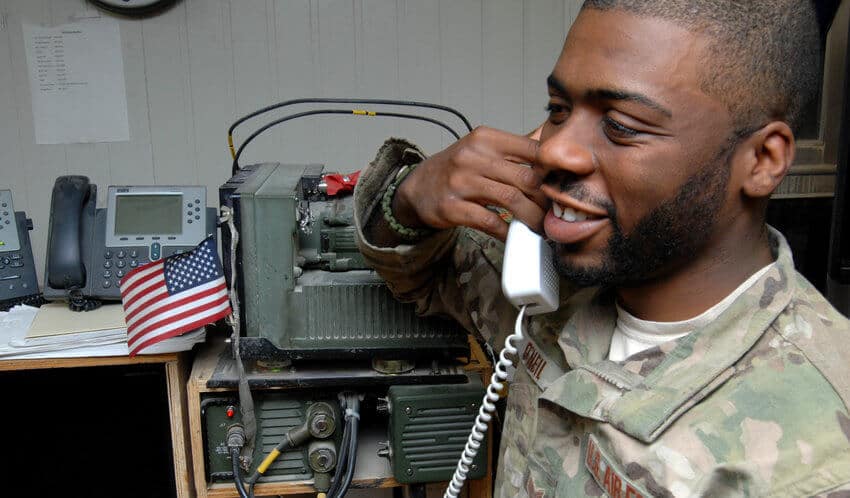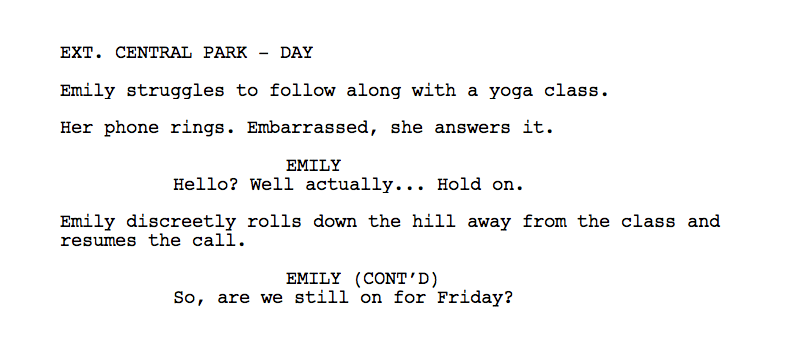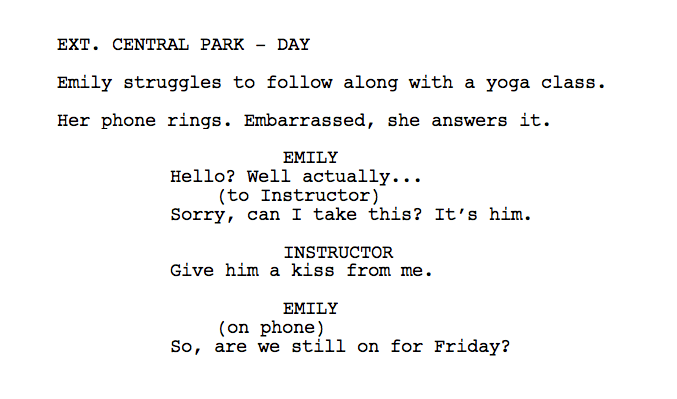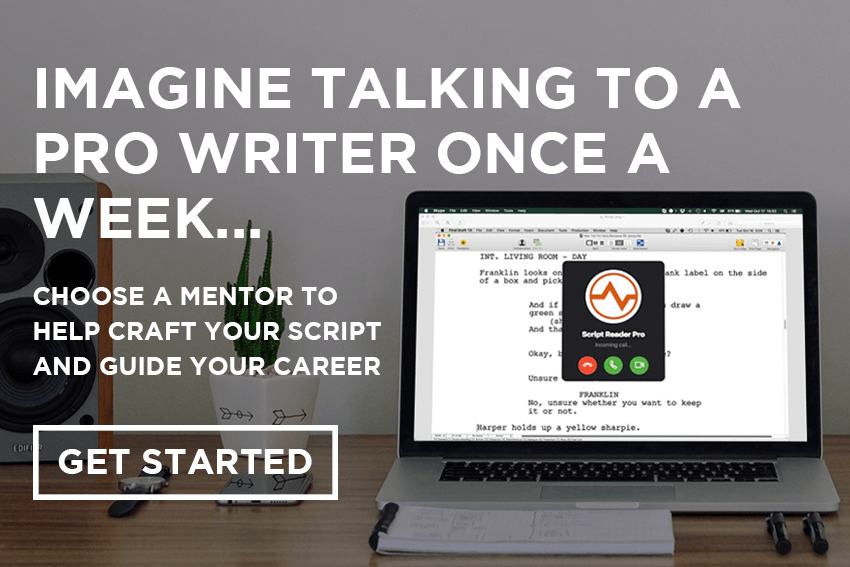
How to write a phone conversation in a screenplay: the definitive guide.
Confused by how to write a phone conversation in a script? In this post, we’re going to take a look at the three main methods you can use to format a screenplay conversation.
We’ll also touch on other do’s and don’ts surrounding phone call dialogue. Such as whether to use “beat” when someone’s listening to the other end of the call.
There are three main ways to write a phone call in a screenplay. Let’s kick off with the simplest method.
How to write a phone call in a script method 1: one character only.
This is formatted pretty much just like normal dialogue. It’s best used for short phone conversations:
 Note how you don’t have to put a parenthetical under the character name saying “on phone.” Or “into phone.” As long as you’ve indicated the character’s picked up the phone, this isn’t needed.
Note how you don’t have to put a parenthetical under the character name saying “on phone.” Or “into phone.” As long as you’ve indicated the character’s picked up the phone, this isn’t needed.
Another thing to avoid is filling one-sided conversations like this with a “beat” every time the character’s listening:

This just takes up valuable real estate in your screenplay. And besides, actors don’t like being told when to pause during phone call dialogue.
Parentheticals can come in handy, though, during one-sided phone conversations. When a character is dealing with other things in the scene while talking on the phone, it can be used like this:
How to write a phone conversation in a screenplay method 2: voiceover (V.O.).
This method is the same as the above, except we hear what the character on the other end is saying via the use of voiceover.
In spec scripts, this method sometimes results in the use of (O.S.) or (O.C.) instead of (V.O.):
 The character on the other end is not off-camera in the same scene. They’re in a completely different location and therefore voiceover (V.O.) is the correct format.
The character on the other end is not off-camera in the same scene. They’re in a completely different location and therefore voiceover (V.O.) is the correct format.
How to write a phone conversation in a screenplay method 3: intercut.
This is perhaps the most common way to format longer phone calls. But also the one that seems to cause the most problems in spec scripts.
This technique simply inserts an INTERCUT in order to jump from one location to another and show both ends of the call on screen at the same time.
The easiest way to format a two-sided conversation like this is to simply establish one character in one location. Then establish the other character in the other location. Then add an INTERCUT — PHONE CONVERSATION and continue the conversation as if they’re in the same location.
Here’s an example:
 Another option is to establish both locations at the same time using an INTERCUT in the opening slugline, like this:
Another option is to establish both locations at the same time using an INTERCUT in the opening slugline, like this:
 Finally, there’s nothing wrong with adding a slugline before every location, but this feels cumbersome. We’d advise you stick to adding INTERCUT to the slugline or some variation of when the second call kicks in:
Finally, there’s nothing wrong with adding a slugline before every location, but this feels cumbersome. We’d advise you stick to adding INTERCUT to the slugline or some variation of when the second call kicks in:
• INTERCUT — PHONE CONVERSATION
• INTERCUT phone conversation
• INTERCUT with Emily in Central Park
• INTERCUT with:
Another variation on this format of seeing and hearing both characters during a phone call is to use a SPLIT SCREEN. This adds a little more stylistic flair but is best used sparingly.
The technique was popular in the 80s and 90s (and perhaps early 00s television) but has always remained fairly rare in film. Here’s the simplest option for formatting a phone call in this way:

The most important thing to remember is to not get dragged down by the smallest details. In most cases, it really doesn’t matter if you use a dash or not. Or place information in the slugline or in the scene.
Just stick to one style throughout and make sure it’s as clear as possible what’s happening.
Should you even use phone calls at all?
In fact, it’s become fashionable in recent times to tell aspiring screenwriters to try and eliminate phone conversations from screenplays altogether. The theory is that they should always be replaced with face-to-face interactions instead.
However, this should depend on the story, not what some screenwriting guru tells you. If you need a phone call in your script, you need a phone call in your script. Just make sure you’re confident you know why it’s there.
###
Got any other ideas on how to write a phone conversation in a screenplay? Let us know in the comments section below. If you want us to check the formatting, spelling, grammar on your screenplay, be sure to check out our Proofread & Formatting service.
Loved this post? Read more on how to write good dialogue…
Script Dialogue: If Your Characters Are Just Talking, You’re Doing It Wrong
On the Nose Dialogue Examples and How to Stop It Killing Your Script
How to Write a Screenplay That’s Unlike Any Other in 6 Steps
[© Photo credits: Pexels]



















Hey, I want to ask how to write correctly when we make a call, but we hear the robot talking…we mention robot voice (V.O) and write as a dialog?
Hey, I want to ask how to write correctly when we make a call, but we hear the robot talking…we mention robot voice (V.O) and write as a dialog?
Hey Alina, no need to add (V.O.) if the robot is in the room. You can just write its dialogue as usual.
I’m writing a script,first time, and its genres are–romance, action, drama,science fictitious,and Where science fictitious is new imaginations. In this movie, last half of movie is rich computer creation to show science fiction. So, can i sell it. If yes,then how?
I do have one question that you didn’t cover in this. If there is an unidentified person on the other side of said phone call, how would you label that person? Otherwise, this is a great article! I love how clear and precise it is!
Thanks, Amira! You could label this any number of ways: “YOUNG GUY (V.O.)” “ELDERLY WOMAN (V.O.)” “MALE VOICE (V.O.)” “FEMALE VOICE (V.O.)” etc.
Great post. Clear and concise. Thank you.
Thanks SJ!
great-job, guys!!!
Greetings from this side of the world!
Currently, am a writing a screenplay that has a very long and necessary flashback of about two different characters but the more I try to format it, the more confused I get.
Please sir/ma, can you help me out?
Thank you.
The character on the other end is not off-camera in the same scene. They’re in a completely different location and therefore voiceover (V.O.) is the correct format….
But why do we use V.O when we are looking at a character talking without moving their lips.
We use voiceover if a character isn’t talking as it’s an inner thought – not something the actor is actually saying.
This is great. As always, thank you.
Thanks a lot, Patrick!
Thanks for the tips. I have one question:
Do we need to end the intercut? Or is a “She hangs up.” sufficient?
Thanks!
“She hangs up” is all that’s necessary!
Hi,
Is a text conversation written the same as a phone conversation – just indicating in the description that they are texting?
Thanks 🙂
Not usually. There’s an example of how to format text messages in this post. Cheers!
Yo.
Nice post on text and phone call formats.
Quick question: What about emojis? Just about them while reading your post and wondered how one could format text emojis in his script
Thanks! You could write “:)” or something like “She texts a smiley face.” It’s not important how you do it as long as the reader gets it.
What if I want to indicate that the person was talking on the phone and then at some point talks with someone close to him at the moment and then goes back to the phone conversation?
You could just add “to Jeff” in parentheticals and then “back on phone” or “on phone” when he/she returns to the call.
Thanks I’ll use it
very interesting details about formatting a phone conversation, appreciate it for putting up.
You’re welcome, John.
Thanks, Howie, you’re welcome!
Can I use INTERCUT only for a phone conversation?
or I can use it for distinct locations, as to indicate a sequence
i.e.
EXT. – SEQ – MAIN STREET/RIVERSIDE AV./GAS STATION/POLICE STATION – DAY
or
EXT. – SEQ – MAIN STREET/RIVER SIDE/GAS STATION/POLICE STATION – DAY/NIGHT
You can use INTERCUT outside of phone calls but it can get muddy on the page. Many writers prefer to use the location itself as a way of directing the eye from location to location. For example:
We INTERCUT between the GAS STATION AND POLICE STATION
GAS STATION
Something exciting happens.
POLICE STATION
Another exciting thing happens.
Your articles are very educating, right here in Nollywood Nigeria, studying and applying your skills in my screenplays has really carved a nitche for me, I’m just waiting for the awards to start coming so I can start telling the whole world how you guys helped me
That’s great to hear, Toni, thanks a lot and best of luck with your writing 🙂
Thanks for taking the time to share this formatting info, just what I was looking for!
I am looking for a screenwriting manager can you help me?
My script has to many phone calls in it I think.
It depends, it can be a problem if you’re relying on phone calls in situations where it’d be more interesting to see the characters interact with each other face-to-face.
This has really help me with my understanding how to write a phone conversation in a screenplay. Eternal blessings to you all at script reader Pro.
Thank you!
Dear Sirs,
I live in Brazil and I am an aspiring screenwriter. I would like to meet someone who lives in the USA for us to share some histories into a partnership.
For two reasons: firstly I am afraid my histories are not easy to be supported by Brazilan producers or agents. Secondly, despite speaking English, my skill in the language is not that good to let me confident to write them in English.
And why not exchanging ideas that would be enriching for all of us?
Contact: nobrito@gmail.com
Perfect! I just ran into this problem last night and was scratching my head. Thanks so much for this post. Very helpful.
Good timing – thanks Jerred!
I feel I know much more now about how to write a phone conversation in a screenplay. Thank you thank you thank you.
Glad the post helped, Linda!
Is formatting a phone call in a script the same with landlines and mobile phones?
Excellent, thanks for posting Script Reader Pro!
Thanks for the shoutout, Francoise!
I usually take a step back a bit and cover the idea of writing cinematically first before tackling the basic formula of how to portray such a scene within the confines of screenwriting format.
Thank you so much for this article, goes a long way, but can you kindly drop your mail, there are stuff I may need your help on. I’m working on a screenplay presently and I keep having to come to google. I will really appreciate this. Thanks a lot.
Hi, yes if you sign up to our newsletter we have a forum in there for asking anything you like. Cheers.
I’ve been embroiled in a debate over formatting voicemail over a speaker. Some insist it’s V.O. But I had a Pro-reader tell me it should be O.S.. Can someone please settle this.
The correct format is V.O. as O.S. would mean the person on the other end is actually in the house, apartment, office or whatever but off-screen.
What about Virtual Reality? I have a script in which two people are talking on VR headsets to each other.
Do people use landlines anymore? Feel like this post should be more about cell phone, VR, Skype, texting etc
What about Skype calls? How do you format those?
Pretty much the same. You’d just want to indicate that the character is on Skype, not the phone.
Character reaction short form ?
Grahish reaction or Grahish r.ac or Grahish r/a or Grahish r/ac or?
The right word is?